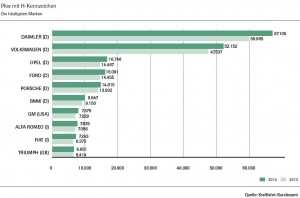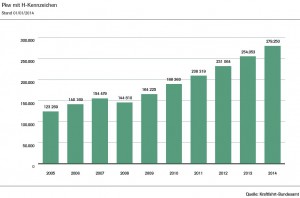
(English below)
Die Zahl der Oldtimer mit H-Kennzeichen in Deutschland ist auch 2013 wieder gestiegen. Zum Jahreswechsel waren 279.250 Pkw mit H-Kennzeichen gemeldet. Damit ist der Bestand im vergangenen Jahr um 9,9 Prozent gegenüber dem Vorjahr gewachsen. Insgesamt gibt es in Deutschland rund 314.000 historische Kraftfahrzeuge mit H-Kennzeichen – neben Pkw zählen dazu auch Motorräder, Nutzfahrzeuge, Zugmaschinen und sonstige Fahrzeuge.
H-Kennzeichen sind für Oldtimerfahrzeuge vorgesehen, die mindestens 30 Jahre alt sind.
„Wir freuen uns über das ständig wachsende Interesse an historischen Fahrzeugen. Oldtimer sind technisches Kulturgut, sie verdienen einen besonderen Schutz“, erklärte Matthias Wissmann, Präsident des Verbandes der Automobilindustrie (VDA). Das Erkennungsmerkmal eines echten Oldtimers ist das H-Kennzeichen. Oldtimer mit H-Kennzeichen haben einen einheitlichen, reduzierten Satz bei der Kraftfahrzeugsteuer von 191 Euro. Wissmann betonte: „Oldtimer sind eine kleine Minderheit aller Kraftfahrzeuge. Sie sollen auch weiterhin ohne Probleme auf öffentlichen Straßen unterwegs sein, denn sie sind große Sympathieträger und ‚fahrender Beweis‘ unserer erfolgreichen Automobilgeschichte.“
In der Rangliste der Modelle mit H-Kennzeichen steht weiterhin der VW-Käfer an der Spitze: 29.135 Käfer mit H-Kennzeichen waren am 1. Januar 2014 angemeldet (plus 7,9 Prozent). Auf Platz 2 bleiben die Fahrzeuge des Modells Mercedes-Benz W123, die zwischen 1975 und 1986 gebaut wurden. Zum Stichtag waren 11.704 W123 mit H-Kennzeichen (plus 32 Prozent) angemeldet – der Bestand steigt aktuell stark an, weil viele dieser Fahrzeuge die Altersgrenze von 30 Jahren überschreiten. Danach folgt ein weiterer Mercedes-Benz: Beim „SL“ der Baureihe 107 (9.051 Fahrzeuge) wuchs der Bestand um 12,5 Prozent. Auf Platz vier geklettert ist der Porsche 911/912. Die Zahl der zugelassenen 911er und 912er mit H-Kennzeichen stieg um gut 17 Prozent auf 7.618 Fahrzeuge. Der Mercedes-Benz „Strich-Acht“ nimmt mit 6.778 Einheiten den fünften Platz ein. Der bei diesem Typ rückläufige Trend, der sich auch bei Fahrzeugen wie Opel Rekord, Ford Taunus oder Mercedes-Benz „Heckflossen“ zeigt, deutet darauf hin, dass nunmehr Fahrzeuge der 1960er Jahre ihren Beliebtheitszenit offenbar überschritten haben. Auch bei Oldtimern gibt es demnach einen „Generationenwechsel“ in der Gunst der Halter.
Im Auftrag des VDA erstellt das Kraftfahrt-Bundesamt regelmäßig eine detaillierte Auswertung der Fahrzeuge mit H-Kennzeichen. 62,2 Prozent aller zugelassenen Pkw, die älter als 30 Jahre sind, verfügen über ein H-Kennzeichen. Nur für diese Fahrzeuge gelten besondere Ausnahmeregelungen, wie etwa die Befreiung vom Fahrverbot in Umweltzonen. Außer dem Mindestalter von 30 Jahren müssen die Fahrzeuge technisch einwandfrei und im originalen Zustand sein.
Quelle: VDA
Wir danken dem VDA für die Bereitstellung dieser Informationen.
—–
Germany: Classic cars with historic number plates growing by 10 percent YoY
Here is our translation of the press release from VDA (Verband der deutschen Automobilindustrie, association of the German automotive industry):
The number of classic cars with historic number plates in Germany (“H-Plates”, of type “…-…H”) increased again in 2013. On 1-Jan-2014, in total 279.250 passenger cars with H-plates were reported. Thus the amount in the past year has grown by 9.9 percent over the previous year. Overall, in Germany there are approximately 314,000 historic motor vehicles with H-plates – this comprises not only cars, but also includes motorcycles, commercial vehicles, tractors and other vehicles.
In Germany, H-plates are provided for vintage cars that are at least 30 years old.
“We are pleased with the ever-growing interest in historic vehicles. Classic cars are of cultural value, they deserve special protection,” said Matthias Wissmann, President of the Association of the Automotive Industry (VDA). The distinguishing feature of a true classic car is the H-Plate. Classic vehicles with H-plates have a uniform, reduced rate of the motor vehicle tax of 191 Euro. Wissmann: “Classic cars are a small minority of the total number of motor vehicles. They should continue to be on public roads without any problems, because they are receive great sympathy and support, and are the continuous proof of our successful automotive history.”
In the ranking of the models with H-plates still is the VW Käfer (“Beetle”) is at the top: 29.135 “Käfer” with H-plates were registered on 1-Jan-2014 (up 7.9 percent). On 2nd place there are vehicles of the model Mercedes-Benz W123, built 1975-1986. To date, 11.704 type W123 (+32percent YoY) were registered with H-plates – the number rises currently quite strongly because many of these vehicles exceed the age limit of 30 years. Runner-up is Another Mercedes-Benz followed: The “SL” Series 107 (9.051 vehicles) grew by 12.5 percent year over year (YoY). On fourth place is the Porsche 911/912. The number of 911 and 912 with H-plate rose by over 17 percent to 7,618 vehicles. The Mercedes-Benz “Strich Acht” (“/8”) earns the fifth position in the ranking with a total of 6,778 units.
The change of the ranking positions observed at this model – and also reflected at other vehicles such as Opel Rekord, Ford Taunus or Mercedes -Benz “fintail” W110 suggests that now cars of the 1960s have exceeded apparently their “popularity zenith”. Also with classic cars there is therefore a “generation change” in favor of the owners.
On behalf of the VDA, the German Federal Motor Vehicle Office (KBA, Kraftfahrtbundesamt) regularly executes a detailed evaluation of vehicles with H-plates. 62.2 percent of all registered cars that are older than 30 years do have an H-plate. To these vehicles special exemptions do apply, such as exemption from the ban in environmental zones. In addition to the minimum age of 30 years, the vehicles must be technically sound and in original condition.
Source: VDA
We’d like to thank the VDA for sharing this important market update with us! 🙂



